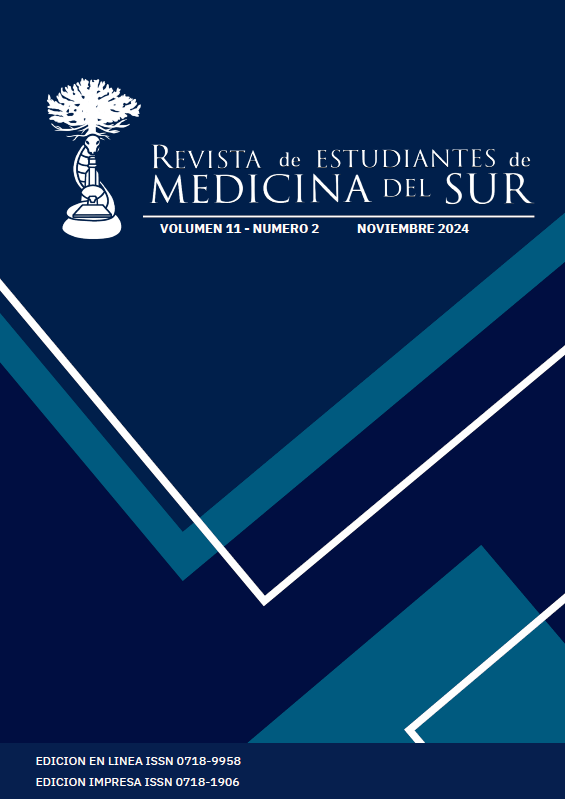Tasas de egresos hospitalarios por erisipela durante el periodo de 2019 a 2022 en Chile
Hospital discharge rate for erysipelas during 2019 to 2022 in Chile
DOI:
https://doi.org/10.56754/0718-9958.2024.230Keywords:
Erysipelas, Hospitalization, Skin Diseases, InfectiousAbstract
Introduction: Erysipelas is an infectious disease generally caused by S. pyogenes. Given the lack of updated epidemiological studies, it is proposed to determine the hospital discharge rate (HDR) due to Erysipelas during the period from 2019 to 2022 in Chile.
Material and methods: Observational, descriptive and cross-sectional study regarding HDR due to Erysipelas during 2019-2022 in Chile, considering sex, age group and hospital stay (N=794). Data were collected from the Department of Statistics and Health Information and the National Institute of Statistics, which were processed with Microsoft 365 ExcelTM. No Ethics Committee was required.
Results: A HDR of 1.13 cases per 100,000 inhabitants was calculated, the highest being 1.66 in 2019. By sex, females had a higher HDR, with 1.25 cases. By age, the group aged 80 years and over recorded the highest HDR with 4.09. The average hospital stay for the period was 7.56 days, being longer in women and in the 15 to 19 year old group.
Discussion: A decrease in HDR is evident in 2020, attributable to the COVID-19 pandemic, followed by a ongoing increase until 2022. The highest HDR is observed in women, which is not consistent with risk factors classically described in the literature available. Regarding hospital stay, both sexes present similar averages, While by age group, the one that stands out is the group of patients between 5 and 19 years old. It is presumed that in elderly patients, the modification of the pattern corresponds to the concomitant complications. This research contributes to the knowledge of the national epidemiological behavior of Erysipelas, being a precedent for future research on the subject.
References
Kaye KS, Petty LA, Shorr AF, Zilberberg MD. Current epidemiology, etiology, and burden of acute skin infections in the United States. Clin Infect Dis [Internet]. 2019;68(3):S193–9. Disponible en: http://dx.doi.org/10.1093/cid/ciz002
Stevens DL, Bryant AE. Streptococcus pyogenes Impetigo, Erysipelas, and Cellulitis. 2022; Disponible en: https://pubmed.ncbi.nlm.nih.gov/36479753/
Flores R, Villarroel JL, Valenzuela F. Enfrentamiento de las infecciones de piel en el adulto. Rev médica Clín Las Condes [Internet]. 2021;32(4):429–41. Disponible en: http://dx.doi.org/10.1016/j.rmclc.2021.06.004.
Estevez B., Leyme V., Gudiño N., Sánchez A. Celulitis infecciosa vs erisipela: diagnóstico y tratamiento. Pol Con [Internet]. 2022;7(6):216-228. Disponible en: https://dialnet.unirioja.es/servlet/articulo?codigo=9042554
Łyko M, Kaczmarek M, Nekrasova P, Anita H-G, Maj J, Jankowska-Konsur A. What factors affect the length of hospitalization in patients with erysipelas? A 10-year retrospective study of patients hospitalized in Lower Silesia, Poland. Adv Clin Exp Med [Internet]. 2021;30(9):981–5. Disponible en: http://dx.doi.org/10.17219/acem/136504
Shapoval SD, Vasylevska LA, Bielinska VO. Clinical features and principles of differential diagnosis of erysipelas. Klin Khir [Internet]. 2021;88(1–2):61–8. Disponible en: http://dx.doi.org/10.26779/2522-1396.2021.1-2.61
Roda Â, Pinto AM, Filipe AR, Travassos AR, Freitas JP, Filipe P. Fatores Clínico-Laboratoriais Associados ao Internamento Prolongado em Doentes com Celulite/Erisipela. Acta Med Port [Internet]. 2019;32(6):448–52. Disponible en: http://dx.doi.org/10.20344/amp.10735
Kosior E, Reich A. Evaluation of antibiotic treatment on the duration of hospitalization of patients with erysipelas and bacterial cellulitis. Dermatol Ther (Heidelb) [Internet]. 2019;9(1):159–66. Disponible en: http://dx.doi.org/10.1007/s13555-018-0276-8
Siches I, Vega J, Chomalí M, Yarza B, Estay R, Goyenechea M, et al. El impacto de Covid19 en el Sistema de Salud y propuestas para la reactivación. 2020. Disponible en: https://www.colegiomedico.cl/wp-content/uploads/2020/08/El-impacto-de-Covid19-en-el-Sistema-de-Salud-y-propuestas-para-la-reactivacion.pdf
Madeira ES, Figueredo LN, Pires BMFB, Souza SR, Souza PA. Potential factors associated with increased chance of erysipelas recurrence. Acta Paul Enferm [Internet]. 2022;35:eAPE02822. https://doi.org/10.37689/acta-ape/2022AO02822
Chamli A, Jaber K, Ben Lagha I, Ben Slimane M, Rabhi F, Doss N, et al. Factors associated with acute and recurrent erysipelas in a young population: a retrospective of 147 cases. Tunis Med [Internet]. 2021;99(8):886–9. Disponible en: https://pubmed.ncbi.nlm.nih.gov/35261016/
Sočan K, Sočan M. Trends in the epidemiology of erysipelas in Slovenia. Acta Dermatovenerol Alp Panonica Adriat [Internet]. 2018;27(1). Disponible en: http://dx.doi.org/10.15570/actaapa.2018.1
Downloads
Published
How to Cite
Issue
Section
Categories
License
Copyright (c) 2024 Hillary Inostroza Muñoz, Melissa Polett Orellana Guzmán, Vicente Javier Pérez Durán, Pablo Ramón Sergio Molina Contreras, Sebastián Alexis Araya Martínez, Bárbara Paz Mena González

This work is licensed under a Creative Commons Attribution-NonCommercial-ShareAlike 4.0 International License.


